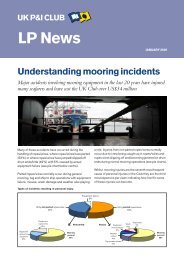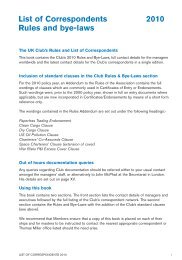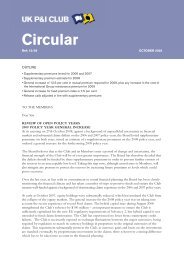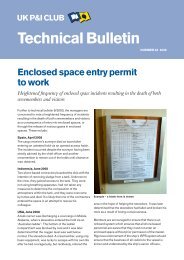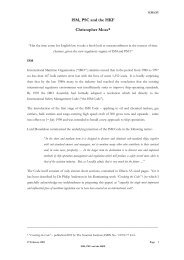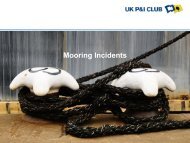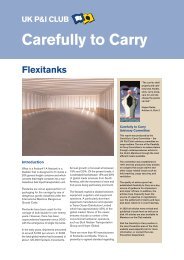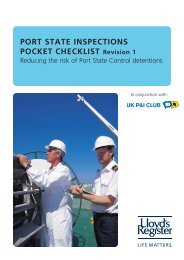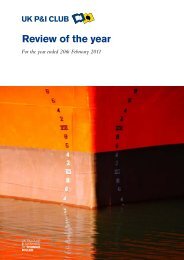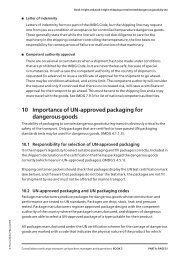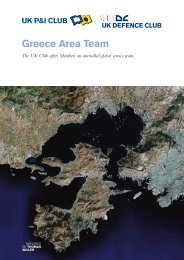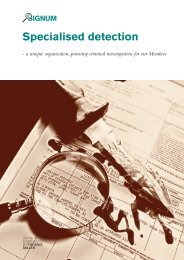Biofuels - UK P&I
Biofuels - UK P&I
Biofuels - UK P&I
Create successful ePaper yourself
Turn your PDF publications into a flip-book with our unique Google optimized e-Paper software.
<strong>UK</strong> P&I CLUB<br />
Carefully to Carry<br />
JULY 2010<br />
<strong>Biofuels</strong>: Marine transport, handling<br />
and storage issues<br />
A major percentage of biofuel is shipped internationally by sea.<br />
It is important, therefore, to understand the issues that need to<br />
be considered if these products are to be carried safely, without<br />
risking damage to either the ship or the cargo<br />
“The carrier<br />
shall properly<br />
and carefully<br />
load, handle,<br />
stow, carry,<br />
keep, care for<br />
and discharge<br />
the goods<br />
carried.”<br />
Hague Rules,<br />
Articles iii, Rule 2<br />
Carefully to Carry<br />
Advisory Committee<br />
The production and use of biofuels as transport fuels has increased<br />
dramatically in recent years. A number of legislative reforms are mandating<br />
the integration of fuels derived from renewable sources into the current<br />
fuel infrastructure. However, the introduction of biofuels has not been<br />
without problems and indeed there is a large amount of research still<br />
ongoing into the properties of biofuels and how they behave when blended<br />
with conventional fossil fuels. This article will discuss some of the issues<br />
surrounding the introduction of biofuels into the present fuel system with<br />
particular focus upon the potential implications for those involved in the<br />
transportation and storage of these products.<br />
Legislative targets<br />
<strong>Biofuels</strong> were originally seen by many as an answer to the problems of<br />
increasing greenhouse gas emissions and global warming. Unlike transport<br />
fuels derived from crude oil, such as diesel and gasoline, biofuels are<br />
produced from renewable sources; that is, sources that can be replenished<br />
at a rate comparable to or faster than the rate at which they are consumed<br />
by humans. Fuels produced from agricultural crops such as corn, wheat,<br />
rapeseed and soybean, which could be quickly and easily replenished and,<br />
in theory, should have a negative overall impact in terms of carbon dioxide<br />
This report was produced by the Carefully<br />
to Carry Committee – the <strong>UK</strong> P&I Club’s<br />
advisory committee on cargo matters.<br />
The aim of the Carefully to Carry<br />
Committee is to reduce claims through<br />
contemporaneous advice to the Club’s<br />
Members through the most efficient<br />
means available.<br />
The committee was established in 1961<br />
and has produced many articles on<br />
cargoes that cause claims and other<br />
cargo related issues such as hold<br />
washing, cargo securing, and ventilation.<br />
The quality of advice given has<br />
established Carefully to Carry as a key<br />
source of guidance for shipowners and<br />
ships’ officers. In addition, the articles<br />
have frequently been the source of<br />
expertise in negotiations over the<br />
settlement of claims and have also been<br />
relied on in court hearings.<br />
In 2002 all articles were revised and<br />
published in book form as well as on disk.<br />
All articles are also available to Members<br />
on the Club website. Visit the Carefully to<br />
Carry section in the Loss Prevention area<br />
of the Club website www.ukpandi.com for<br />
more information, or contact the Loss<br />
Prevention Department.
emissions, seemed an ideal solution<br />
for governments facing increasingly<br />
difficult decisions with regard to the<br />
links between pollution and climate<br />
change, and legislative targets were<br />
quickly put in place mandating the<br />
integration of biofuels into the<br />
current transport fuel infrastructure.<br />
However, it was not long before<br />
serious questions were raised with regard to the<br />
environmental credentials and overall sustainability of<br />
the commercially available biofuels. Issues included<br />
the use of crops which would normally be used for food<br />
being put into biofuel production, the questionable<br />
carbon dioxide emissions savings when considering the<br />
overall production process (‘wells to wheels’),<br />
deforestation to make way for biofuel crop plantations<br />
and the use of environmentally harmful fertilisers and<br />
pesticides employed in growing the crop feedstock.<br />
Indeed it was suggested by some parties that biofuels<br />
could in reality be causing more harm than good to the<br />
environment.<br />
Amid these growing concerns, the <strong>UK</strong> Government has<br />
recently decided to amend the targets set out in the<br />
Renewable Transport Fuel Obligation (RTFO), a<br />
directive aimed at reducing greenhouse gas emissions<br />
from road transport. The RTFO requires that by<br />
2013/14, 5% by volume of all fuel sold in <strong>UK</strong> forecourts<br />
is to come from renewable sources, with intermediate<br />
targets of approximately 3.5%, 4% and 4.5% for the<br />
periods 2010/11, 2011/12 and 2012/13 respectively.<br />
These targets represent a slowdown in the required<br />
biofuels targets, but they are likely to be reviewed in<br />
2013/14 in order to assess the progress of the <strong>UK</strong><br />
RTFO in complying with the wider EU initiative to<br />
reduce carbon emissions, the Renewable Energy<br />
Directive. This directive was recently reviewed and<br />
agreed in December 2008, and mandates that by 2020,<br />
10 per cent of all automotive fuel consumption by<br />
energy content should be sourced from renewable<br />
energy sources.<br />
Amid all the uncertainty, it appears likely that the<br />
worldwide push for increasing biofuel use as a means<br />
of reducing overall carbon dioxide emissions will<br />
continue, and one can reasonably expect the biofuels<br />
market to continue to grow. Much of the biofuel is<br />
shipped internationally by sea. For example, first half<br />
figures for the 2008/2009 period indicate that 670<br />
million litres of biofuels were supplied to the <strong>UK</strong><br />
transport market. Only 8% of the biofuel supplied was<br />
produced from within the <strong>UK</strong>, such that 92%<br />
(approximately 616 million litres) of biofuel was<br />
imported. A recent report by Pike Research estimated<br />
that the global biodiesel and ethanol markets are likely<br />
to reach US$ 247 billion in sales by 2020, up from<br />
US$ 76 billion in sales predicted for 2010.<br />
In order to meet the necessary targets, the quantity of<br />
biofuels shipped both into the <strong>UK</strong> and worldwide is<br />
likely to increase, and it is therefore important for those<br />
involved in the carriage of biofuels to understand the<br />
issues that need to be considered if these products are<br />
to be carried safely, without risking damage to either<br />
the ship or the cargo.<br />
Current biofuels<br />
There are presently two main classes of biofuels in<br />
widespread use; biodiesel (or more correctly, FAME)<br />
and bioethanol. The two are very different in their<br />
properties and therefore have different issues to<br />
consider if they are to be safely shipped, handled,<br />
stored and used. Each will be considered in turn.<br />
FAME/Biodiesel<br />
Biodiesel is a fuel derived from vegetable oils or animal<br />
fats, although the term ‘biodiesel’ is too vague a<br />
description and we therefore use the more correct<br />
terminology, Fatty Acid Methyl Esters (FAME), when<br />
discussing these fuels. FAME is the product of reacting<br />
a vegetable oil or animal fat with an alcohol (methanol,<br />
a petrochemical which is generally derived from natural<br />
gas or coal) in a process known as transesterification.<br />
When compared to conventional diesel derived from<br />
crude oil, vegetable oils and animal fats generally have<br />
higher viscosities (which means they are more difficult<br />
to pump and store without heating) and are more<br />
unstable (which means they are more likely to degrade<br />
during storage, handling and end-use). The<br />
transesterification process brings the properties of the<br />
raw materials closer to those of a conventional diesel,<br />
making the product more suitable for use as a road<br />
transport fuel. However, whilst the FAME produced can<br />
be used neat as a fuel, it is more commonly blended<br />
with conventional petroleum diesel for use in diesel<br />
engines.<br />
The ASTM has described a system of nomenclature for<br />
naming FAME/diesel blends (see ASTM D6751). Pure
FAME is denoted B100, standing for 100% ‘biodiesel’.<br />
Other common blends include B5 (5% ‘biodiesel’ and<br />
95% conventional diesel), B7 (the EN590 European<br />
diesel standard allows up to 7% by volume FAME in<br />
diesel) and B20 (20% ‘biodiesel’ and 80%<br />
conventional diesel). In the <strong>UK</strong>, a major supermarket<br />
chain has introduced B30 (30% ‘biodiesel’ and 70%<br />
conventional diesel) pumps onto a number of their<br />
forecourts (Motor Consult Update November 2008).<br />
However, this fuel is not currently governed by any<br />
standards and is not approved for use by many of the<br />
major automobile manufacturers.<br />
Raw materials for FAME production<br />
A wide number of raw materials can be used for the<br />
production of FAME, including palm oil, coconut oil,<br />
rapeseed oil, soybean oil, tallow and used cooking oils.<br />
A general FAME cargo might be the product of<br />
processing any one of these raw materials, or may<br />
indeed be a mixture of FAMEs produced from different<br />
raw materials. Each raw material would give FAME of a<br />
different chemical composition, with correspondingly<br />
different characteristics. For example, if we compare a<br />
FAME derived from palm oil (PME) with a FAME derived<br />
from rapeseed oil (RME), it is possible to notice an<br />
immediate visible difference between the two – namely<br />
that at normal <strong>UK</strong> winter temperatures the PME is likely<br />
to be solidified whereas the RME will be a liquid. It is<br />
the chemical composition of the raw materials and the<br />
FAMEs produced from them that explains many of the<br />
different characteristics displayed.<br />
One of the most important chemical characteristics of<br />
FAME is the structure and composition of the fatty acid<br />
methyl ester groups, which will be determined by the<br />
fatty acid components of the raw material used in the<br />
production process. Pictorially, we can see a<br />
difference if we look at the structures of two different<br />
fatty acids below – one a saturated fatty acid and one<br />
an unsaturated fatty acid – the saturated fatty acid has<br />
a ‘straight chain’ of carbon atoms (circled in red)<br />
whereas the unsaturated fatty acid has, in this case,<br />
two ‘double bonds’ present in the hydrocarbon chain.<br />
These are circled in green and result in ‘kinks’ in the<br />
hydrocarbon chain:<br />
Myristic Acid – A saturated fatty acid<br />
Linoleic Acid – An unsaturated fatty acid<br />
FAME species which are composed of a relatively high<br />
proportion of saturated fatty acid methyl esters, for<br />
example, palm oil derived FAME (denoted PME) will in<br />
general be relatively stable to unwanted degradation<br />
reactions, but will have poorer cold temperature<br />
performance. FAME species which are composed of a<br />
relatively high proportion of unsaturated fatty acid<br />
methyl esters, for example, soybean oil derived FAME<br />
(denoted SME), will display markedly different<br />
behaviour, typically having improved cold temperature<br />
properties in comparison to PME, but being less stable<br />
to degradation reactions. The reason for the improved<br />
cold-temperature behaviour displayed by the FAME<br />
species high in unsaturated fatty acid methyl esters is<br />
that for every double bond in the hydrocarbon chain<br />
and associated kink in the molecule, the individual<br />
molecules cannot pack as closely together thereby<br />
reducing intermolecular forces and correspondingly<br />
decreasing the melting point. However, it is the<br />
presence of the double bonds in the unsaturated FAME<br />
species that infers the greater degree of instability<br />
upon the molecules – the double bond sites render the<br />
molecule prone to oxidative degradation.<br />
The presence and composition of other chemical<br />
constituents are also important. For example, FAMEs<br />
with high levels of vitamin E are thought to be more<br />
stable to unwanted oxidative degradation reactions.<br />
Recent research reported in Biodiesel magazine has<br />
identified the formation of sediments in stored B5 and<br />
B20 blends. Analysis of the sediment components<br />
suggests that they originate from the oxidation of<br />
unsaturated fatty acid methyl ester components of<br />
FAME. However, the addition of antioxidants to the<br />
neat FAME prior to blending was found to prevent<br />
sediment formation. Vitamin E is a natural antioxidant<br />
which would appear to prevent the occurrence of such<br />
unwanted oxidation reactions.<br />
FAME problems<br />
Water contamination: A major problem with regard<br />
to the carriage of FAME by sea is the issue of water<br />
contamination. FAME is a hygroscopic material, which<br />
means that is will absorb water from its surrounding<br />
environment, including the atmosphere. This renders
not under a positive pressure of dry inert gas. Despite<br />
having relatively high flash points, FAME cargos are<br />
generally carried under a (dry) nitrogen blanket in order<br />
to avoid the potential increase in water due to<br />
absorption of moisture from tank ullage spaces.<br />
FAME very sensitive to water contamination. The<br />
current maximum allowable water content in the<br />
European EN 14214 and American ASTM D6751 FAME<br />
standards is 500 mg/kg, although often selling<br />
specifications are lower (300 mg/kg being a typical<br />
maximum water content on a sales specification),<br />
reflecting the high potential for water pick-up in this<br />
material.<br />
Unlike most conventional diesels, in which any undissolved<br />
water present will generally settle out over a<br />
period of time, FAME can hold water in suspension up<br />
to relatively high levels (above 1000 mg/kg). Apart from<br />
the fact this will render the cargo off-specification for<br />
water content, the presence of water can promote<br />
unwanted hydrolytic reactions, breaking down the<br />
FAME to form free fatty acids, which can again affect<br />
certain specification parameters for the material – such<br />
species are corrosive and may attack exposed metal<br />
surfaces. Additionally, once a certain threshold level of<br />
water content is reached, water can separate out from<br />
the FAME, forming a separate (and potentially<br />
corrosive) free water phase. The possibility of phase<br />
separation occurring is greater for blends of FAME and<br />
conventional diesel.<br />
The presence of a FAME/water interface provides ideal<br />
conditions for the promotion of unwanted<br />
microbiological growth, which may in turn lead to filter<br />
blocking and corrosion problems. Certain publications<br />
have referenced the greater degree of biodegradability<br />
of FAME as a positive factor when dealing with<br />
environmental spillages. This is indeed correct, but by<br />
the same token this factor means that FAME is<br />
considerably more prone to microbiological attack than<br />
a conventional fossil fuel, with the associated<br />
problems mentioned above. A number of studies have<br />
been performed in this area which highlight the need<br />
for further detailed analysis and research into the<br />
potential for serious microbiological contamination<br />
occurring at various stages in the biofuel supply chain.<br />
Possible sources of water contamination aboard a<br />
vessel range from the obvious – sea water ingress or<br />
residues of tank washing operations – to the less<br />
obvious – moisture in an inert gas blanket produced<br />
from a faulty flue gas generating system, or<br />
atmospheric humidity in tanks’ ullage spaces that are<br />
Stability problems: FAMEs are generally more prone<br />
to issues with regard to their stability than conventional<br />
petroleum diesel. We have mentioned previously that<br />
certain FAME/diesel blends can be oxidised to form<br />
unwanted degradation products and that the addition<br />
of antioxidants may prevent the formation of these<br />
sediments. FAME can degrade under the influence of<br />
air, heat, light and water, and degradation may occur<br />
during transport, storage or even during end-use. FAME<br />
cargoes may display different levels of stability<br />
dependent upon their<br />
composition and the<br />
feedstock(s) used in<br />
their production. In<br />
general FAME with<br />
higher levels of<br />
unsaturated fatty acids,<br />
such as soybean and<br />
sunflower oil derived<br />
FAME, will be less<br />
stable than those<br />
composed of higher<br />
levels of saturated fatty<br />
acids, for example, palm<br />
oil or coconut oil derived<br />
FAMEs.<br />
Potential shipping problems include the promotion of<br />
degradation reactions by trace metals (copper heating<br />
coils or zinc-containing tank coatings have the<br />
potential to cause deterioration in quality) and thermal<br />
stability issues if the FAME cargoes are stored next to<br />
heated tanks, for example, bunker settling tanks. Issues<br />
with the promotion of instability by the presence of<br />
trace metals are worse for B100 than for lower<br />
biodiesel blends (e.g. B5, B20). Degradation reactions<br />
can form insoluble sediments and gums, which may<br />
increase the viscosity of the FAME, lead to filter<br />
blocking or potentially further decompose to other more<br />
corrosive species. The carriage of FAME under dry<br />
nitrogen blankets can also help to prevent unwanted<br />
degradation reactions caused by the material coming<br />
into contact with air.<br />
Low temperature behaviour: The poor low<br />
temperature properties of FAME when compared to<br />
conventional diesel may give rise to issues where<br />
FAME cargoes are shipped through extremes of cold<br />
temperature. It is possible for certain FAMEs to form<br />
waxy precipitates at low temperatures which will then<br />
not re-dissolve when the product is reheated, although<br />
this would not appear to be a common problem.
However, there is the potential for FAME cargoes<br />
shipped from a warm, humid climate to extremely cold<br />
conditions, if the correct measures for heating the<br />
cargo are not applied, to form unwanted waxy<br />
precipitates which may lead to specification failure or<br />
pumping problems.<br />
As has been mentioned previously, it is generally<br />
recognised that FAMEs produced from vegetable oils<br />
with relatively high proportions of unsaturated fatty<br />
acids, for example, soybean oil, will have better coldtemperature<br />
properties than FAMEs produced from<br />
vegetable oils with high proportions of saturated fatty<br />
acids, such as palm oil. It is therefore vital that the<br />
correct heating instructions are issued and followed –<br />
an understanding of the nature of the FAME will impact<br />
upon the necessary heating instructions – this should<br />
be borne out by the appropriate research into the origin<br />
of the FAME and indicated by the results of any preshipment<br />
testing.<br />
FOSFA International (The Federation of Oils, Seeds<br />
and Fats Associations Ltd) has now included FAME<br />
products in its published heating recommendations:<br />
100 ppm maximum FAME content (DEFSTAN 91-91<br />
Issue 6).<br />
In May 2008 a number of jet fuel storage tanks at<br />
Kingsbury supply terminal and Birmingham Airport were<br />
quarantined after it was discovered that samples of the<br />
jet fuel in question contained up to 20 ppm of FAME.<br />
The cause of the contamination is thought to have<br />
been as a result of mixing of jet fuel with B5 diesel in<br />
the distillate manifold at Kingsbury terminal. As an<br />
indication of the very small quantities needed to cause<br />
such a contamination, the 5 ppm specification limit<br />
would be equivalent to just 1 litre of B5 diesel in 10,000<br />
litres of jet fuel.<br />
When vessels may potentially carry jet fuel cargoes<br />
following on from FAME or FAME/diesel blends, the JIG<br />
recommends that care must be taken with tank<br />
cleaning and flushing and draining common lines<br />
including sea or jetty loading lines. From experience,<br />
they suggest that switching from a B5 to jet fuel<br />
requires at least a hot water tank wash (but preferably<br />
also an intermediate FAME-free cargo) to remove<br />
FAME residue. Switching from neat FAME to jet fuel<br />
Oil Type Temperature during voyage Temperature at discharge<br />
Min ( o C) Max ( o C) Min ( o C) Max ( o C)<br />
FAME from<br />
Maize/Rapeseed/Soya/Sunflower<br />
Ambient<br />
Ambient<br />
FAME from<br />
Coconut/Palm/Palm Kernel/Tallow<br />
25 30 30 40<br />
FAME contamination of jet fuel: FAME is a surface<br />
active material and can adsorb onto the walls of tanks<br />
or pipelines and de-adsorb into subsequently carried<br />
products. This can be an issue where multi-product<br />
pipelines or storage tanks are utilised, or where ships<br />
carry jet fuel cargoes after carrying FAME/diesel<br />
blends.<br />
The latest DEFSTAN 91-91 jet fuel specification states<br />
that jet fuel containing less than 5 parts per million<br />
(ppm) FAME can be considered acceptable for use,<br />
that is, can be considered as being free from any<br />
FAME. Full inclusion of this specification limit into the<br />
DEFSTAN 91-91 standard is pending on the<br />
development of a suitable test method to accurately<br />
identify FAME in jet fuel at this level. A test program<br />
conducted by the Joint Inspection Group (JIG) tested<br />
jet fuel dosed with various FAMEs up to 400 ppm and<br />
found no significant affect on specification test results,<br />
and the inclusion of the 5 ppm maximum limit into the<br />
DEFSTAN 91-91 standard has been granted on the<br />
basis that the aviation industry is working towards a<br />
requires particular care and some advocate at least<br />
three intermediate (FAME free) cargoes plus the hot<br />
water wash before loading jet fuel (source: JIG Bulletin<br />
No. 21).<br />
As 5 ppm is such a low level of contamination, there is<br />
the potential for erroneous results to be produced from<br />
inaccuracies in the test methods or incorrect sample<br />
handling. The DEFSTAN 91-91 standard suggests that<br />
the currently specified method of flushing sample<br />
containers three times for jet fuel samples may not be<br />
sufficient to remove traces of FAME, which may even<br />
be transferred from contaminated gloves. This could<br />
potentially lead to false positive detection of FAME in<br />
actually on-specification material, resulting in<br />
erroneous claims being made. It is therefore<br />
recommended that new sample containers and new<br />
gloves are used when sampling jet fuel cargos.<br />
For products tankers carrying multiple products, the<br />
danger of inadvertently contaminating a cargo of jet<br />
fuel with traces of FAME is a very real risk, even if it
standard, ISO 8217:2005, required under point 5.1 of<br />
Section 5 – General Requirements that the fuels to be<br />
classified in accordance with the standard should be<br />
“homogeneous blends of hydrocarbons derived from<br />
petroleum refining.” This was interpreted as precluding<br />
the fuel from containing any bio-derived components.<br />
During the preparation of the fourth edition of the<br />
standard, the working group committee responsible for<br />
the production of the standard considered the topic of<br />
biodiesel and the potential for the material to find its<br />
way into the marine fuel supply chain. It concluded that<br />
it was almost inevitable that as a result of blending<br />
FAME into automotive diesel that some marine<br />
distillates and possibly even marine residual fuels may<br />
contain a proportion of FAME as a result of cross<br />
contamination within the distribution system (Source:<br />
Bunkerworld Forum 03/09/2009).<br />
does not initially appear that there is any potential for<br />
cross contamination to occur. For example, ultra-low<br />
sulphur diesel meeting the EN590 specification may<br />
appear in the shipping documents as ULSD, which<br />
would not immediately indicate that the product<br />
contained any FAME. However, the EN590 diesel<br />
specification allows up to 7% by volume FAME<br />
content. If the ship’s tanks and lines are not completely<br />
stripped of all the ULSD prior to loading a cargo of jet<br />
fuel, the quantity of ULSD containing 7% FAME<br />
needed to render the jet fuel cargo off-specification<br />
would be very small.<br />
Solvent behaviour: An interesting property of FAME<br />
is its ability to act as a solvent, taking up any organic<br />
residue, dirt or scale that may have accumulated on<br />
surfaces of tanks or pipelines. This can have the effect<br />
of cleaning out the dirty storage or pumping systems<br />
but contaminating the FAME itself, and may lead to<br />
subsequent fouling of filters or pump blockages.<br />
As an indication of its solvent strength, researchers<br />
from Iowa State University are investigating how the<br />
solvent properties of FAME can benefit military<br />
applications, by looking into whether or not certain<br />
varieties of waste generated in-situ in battlefield<br />
locations will dissolve into biodiesel, and also if<br />
stationary engines can be run on the biodiesel<br />
containing certain levels of dissolved plastics.<br />
FAME is known to attack and quicken the ageing<br />
process of certain materials, including elastomers<br />
(which may be used as seals, valves, gaskets etc.) –<br />
materials should be checked for compatibility with<br />
FAME and FAME/diesel blends by consultation with the<br />
equipment manufacturer.<br />
Biodiesel in bunkers: On 15 June 2010 the fourth<br />
edition of the marine fuels standard, ISO 8217:2010,<br />
was issued. The previous edition of the marine fuels<br />
As such, the ISO 8217:2010 International Standard<br />
now additionally requires under point 5.4 of Section 5 –<br />
General Requirements<br />
that “The fuel shall be<br />
free from bio-derived<br />
materials other than ‘de<br />
minimis’ levels of FAME<br />
(FAME shall be in<br />
accordance with the<br />
requirements of EN<br />
14214 or ASTM D6751).<br />
In the context of this<br />
International Standard,<br />
‘de minimis’ means an<br />
amount that does not<br />
render the fuel<br />
unacceptable for use in marine applications. The<br />
blending of FAME shall not be allowed.”<br />
Annex A of the ISO 8217:2010 International Standard<br />
considers the issue of bio-derived products and FAMEs<br />
finding their way into marine fuels in more detail.<br />
Annex A states that notwithstanding the fact that FAME<br />
has “good ignition, lubricity properties and perceived<br />
environmental benefits”, there are “potentially specific<br />
complications with respect to storage and handling in a<br />
marine environment”, including:<br />
●<br />
●<br />
●<br />
●<br />
A tendency to oxidation and long term storage issues<br />
Affinity to water and risk of microbial growth<br />
Degraded low-temperature flow properties<br />
FAME material deposition on exposed surfaces,<br />
including filter elements.<br />
It is recognised that there are a number of different<br />
sourced FAME products each with their own particular<br />
characteristics which may impact upon storage,<br />
handling, treatment, engine operations and emissions.
The standard states that in “...those instances where<br />
the use of fuels containing FAME is being<br />
contemplated, it should be ensured that the ship’s<br />
storage, handling, treatment, service and machinery<br />
systems, together with any other machinery<br />
components (such as oily-water separator systems) are<br />
compatible with such a product.”<br />
The meaning of a ‘de minimis’ level is expanded upon<br />
in Annex A of the ISO 8217:2010 international<br />
Standard. It is noted that determining a ‘de minimis’<br />
level is not straightforward for a number of reasons,<br />
including the fact that there is no standardised<br />
analytical technique for detecting FAME materials in<br />
fuel oils and that, in most cases, sufficient data is not<br />
As we have mentioned previously, there has been<br />
significant experience worldwide in the use of ethanol<br />
as a fuel or fuel-additive. In the USA there has been<br />
over ten years successful use of gasoline containing up<br />
to 10% ethanol (E10), and in Brazil blends containing<br />
up to 85% to 100% ethanol (E85 and E100) are<br />
commonly used in flexible-fuel vehicles. The current<br />
European gasoline specification, EN228, allows up to<br />
5% ethanol by volume (E5).<br />
Whilst bioethanol can be produced from a number of<br />
raw materials, including sugar cane, corn and wheat,<br />
the raw materials do not impart the same variation in<br />
properties of the end product fuel as is the case with<br />
FAME. However, there are still a number of potential<br />
hazards for consideration.<br />
Bioethanol problems<br />
yet available with respect to the effects of FAME<br />
products on marine fuel systems. For the purposes of<br />
the International Standard, for the four grades of<br />
distillate fuel (DMX, DMA, DMZ & DMB when clear and<br />
bright) it is recommended that ‘de minimis’ be taken as<br />
“not exceeding approximately 0.1 volume %” when<br />
determined in accordance with test method EN 14078.<br />
For DMB when not clear and bright and for all<br />
categories of residual fuels, the standard notes that “...<br />
‘de minimis’ cannot be expressed in numerical terms<br />
since no test method with formal precision statement is<br />
currently available. Thus, it should be treated as<br />
contamination from the supply chain system.”<br />
Water contamination: Issues with regard to the<br />
carriage of bioethanol and bioethanol-gasoline blends<br />
include the potential for damaging water<br />
contamination. We mentioned previously that ethanol<br />
is hygroscopic and highly soluble in water. Small<br />
quantities of water can be dissolved in gasoline/<br />
bioethanol blends, but, dependent upon temperature<br />
and the gasoline/bioethanol blend ratio, there is a<br />
critical threshold level of water that can be dissolved.<br />
Once this threshold level has been exceeded,<br />
irreversible phase separation will occur whereby the<br />
water causes the ethanol to separate from the<br />
gasoline, forming an alcohol rich water/ethanol<br />
aqueous phase and an alcohol poor gasoline phase.<br />
The alcohol rich aqueous phase will collect at the<br />
bottom of the ship’s tank or storage tank. This phase is<br />
likely to be highly corrosive and will not be able to be<br />
used as fuel. In addition, if such phase separation does<br />
occur it is possible that the gasoline phase will be<br />
Bioethanol<br />
Bioethanol refers to ethanol produced by the<br />
fermentation of renewable sources of sugar or starch<br />
crops. Unlike FAME, bioethanol is a single chemical<br />
compound, the properties of which are well<br />
documented and understood. It is a volatile, colourless<br />
liquid which is miscible with water and also<br />
hygroscopic. Ethanol is the alcohol found in alcoholic<br />
beverages and is also commonly used as a solvent in<br />
perfumes, medicines and paints. However, the most<br />
common use for ethanol is as a fuel or fuel-additive.<br />
Ethanol for use as a fuel is generally dosed with a<br />
‘denaturant’ to render it unsuitable for human<br />
consumption.
classed as Pollution Category Z, which means that it is<br />
considered to present a “minor hazard to either marine<br />
resources or human health” if discharged into the sea<br />
from tank cleaning or deballasting operations and<br />
therefore “justifies less stringent restrictions on the<br />
quality and quantity of the discharge into the marine<br />
environment”. Whilst the regulations do not require<br />
ethanol to be carried on a chemical tanker, ethanol is<br />
generally shipped on chemical tankers to maintain the<br />
integrity of the product.<br />
It should be noted at this juncture that the terms<br />
biodiesel and bioethanol do not appear in the IBC<br />
Code. As it is a requirement that the proper shipping<br />
name be used in the shipping document for describing<br />
any product to be carried which appears in the IBC<br />
Code, these terms cannot be used to describe the<br />
products being carried.<br />
The situation becomes somewhat more confusing when<br />
we consider how blends of conventional fossil fuels and<br />
biofuels are shipped, and which Annex of MARPOL they<br />
fall under. MARPOL Annex I covers the prevention of<br />
pollution by oil and MARPOL Annex II covers the control<br />
of pollution by noxious liquid substances carried in bulk.<br />
Blends of biofuels and conventional fuels are essentially<br />
mixtures of mineral oil based hydrocarbons and noxious<br />
liquid substances. At present, the International Maritime<br />
Organization (IMO) Bulk Liquids and Gases subcommittee<br />
are addressing the issue of how to classify<br />
the blends. In the interim, provisional measures are in<br />
place which state that blends of conventional fossil<br />
fuels and biofuels in which the proportion of biofuel<br />
component is less than 15% should be carried under the<br />
provisions of MARPOL Annex I. Blends with a proportion<br />
of biofuel component greater than 15% would have<br />
required the shipper in question to contact an<br />
administrator for a decision on how the product should<br />
be carried. These measures were to remain in place<br />
until July 2009 but have recently been extended until<br />
July 2011 and have been developed to take the form of a<br />
3-band system as follows:<br />
Band 1: 85% or more petroleum oil (15% or less FAME)<br />
– Product is carried as an Annex I cargo. Oil discharge<br />
monitoring equipment (ODME) should be approved/<br />
certified for the mixture carried or tank residues and all<br />
tank washings should be pumped ashore.<br />
Band 2: More than 1% but less than 85% petroleum oil<br />
(15% to 99% FAME) – Product carried as an Annex II<br />
cargo. Blend is treated as tripartite mixture in line with<br />
MEPC.1/Circ.512 but ship type cannot be lower<br />
specification than any component in the blend;<br />
or<br />
Cargo treated as pollution category X, ship type 2 with<br />
worst case minimum carriage requirements assigned<br />
(based on analogous products in the IBC Code such as<br />
pyrolysis gasoline, butyl benzene or the generic entry<br />
for n.o.s. (4) products)<br />
Band 3: 1% or less petroleum oil (Greater than 99%<br />
FAME) – Product carried as Annex II cargo and cargo<br />
treated as the Annex II product contained in the blend.<br />
Issues of concern include the potential effect that<br />
FAME and ethanol cargoes might have on ODME<br />
equipment – it is understood that further testing is<br />
needed to clarify this issue. The varying blend levels<br />
also impact upon how the cargo is measured – work is<br />
currently being undertaken on samples of FAME from<br />
various origins and at different blend levels to establish<br />
suitable volume correction factors (VCFs) to be used in<br />
cargo measurement.
Future developments<br />
Up to this point, discussion has been limited to FAME<br />
and bioethanol, the so called ‘first-generation’ biofuels.<br />
The Renewable Energy Directive was updated in<br />
December 2008 to include sustainability criteria for<br />
biofuels, amid worries that the biofuels currently in<br />
production were not being produced in a sustainable<br />
manner. In order to meet the various legislative targets,<br />
not only will the volumes of biofuels used need to<br />
increase, but technology will need to be developed and<br />
made commercially viable to bring new, sustainable<br />
biofuels onto the market. Examples of such biofuels<br />
include; biodiesel produced from algal oil, biodiesel<br />
produced from the crop jatropha (which does not<br />
compete with food crops for land), bio-butanol (which is<br />
a slightly longer chain alcohol than ethanol) produced<br />
from renewable sources of biomass, and ‘renewable<br />
diesel’, a synthetic diesel which would meet the EN590<br />
diesel standard, produced by the catalytic<br />
hydrogenation of vegetable oils.<br />
Conclusions<br />
It is clear that the integration of biofuels and blends of<br />
biofuels with conventional fuels into our current fuel<br />
infrastructure has raised a number of issues, many of<br />
which were unforeseen and have only come to light<br />
after the introduction of the fuels. The majority of the<br />
problems concern FAME, both as a neat product and as<br />
a blend with petroleum diesel. The variety in the<br />
feedstock which can be used to produce FAME can<br />
impart very different properties on the FAME produced.<br />
In Europe there is currently only a single FAME<br />
standard, and the particular type of FAME, and<br />
therefore the properties the material may be expected<br />
to display, may not always be clear from the shipping<br />
documents.<br />
The major issues for consideration for those involved in<br />
shipping FAME are the high potential for water<br />
contamination and associated problems with<br />
microbiological spoilage, and, whilst a 5 ppm limit<br />
remains in the DEFSTAN 91-91 jet fuel specification,<br />
the potential for contamination of jet fuel cargos by<br />
traces of FAME. Additionally, the relative instability and<br />
sensitivity of the material to low temperatures and<br />
trace metals require extra care in terms of how the<br />
product is handled. Bioethanol and gasoline blends are<br />
also sensitive to water contamination with the potential<br />
for irreversible phase separation to occur if the level of<br />
water passes a certain threshold level.<br />
Of course, it is possible that as blend levels increase,<br />
new and unforeseen problems will arise that will<br />
require further research and new approaches to our<br />
way of dealing with these materials. It is likely that<br />
biofuels will continue to provide a very real challenge<br />
to all those involved in their production and distribution<br />
over the coming years, and a knowledge of the often<br />
quite unique properties that these products display will<br />
be very beneficial for those wanting to minimise the risk<br />
of facing unwanted claims.<br />
Acknowledgements: Richard Minton, Minton Treharne & Davies Ltd<br />
<strong>UK</strong> P&I CLUB<br />
IS MANAGED<br />
BY THOMAS<br />
MILLER<br />
For further information please contact:<br />
Loss Prevention Department, Thomas Miller P&I Ltd<br />
Tel: +44 20 7204 2307. Fax +44 20 7283 6517<br />
Email: lossprevention.ukclub@thomasmiller.com




